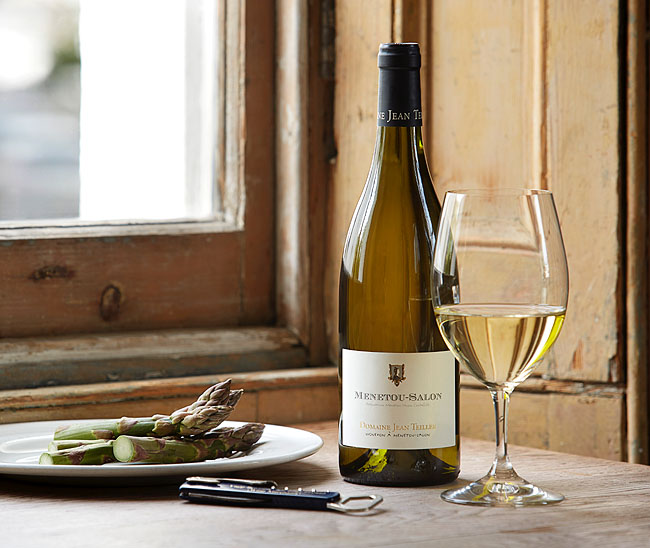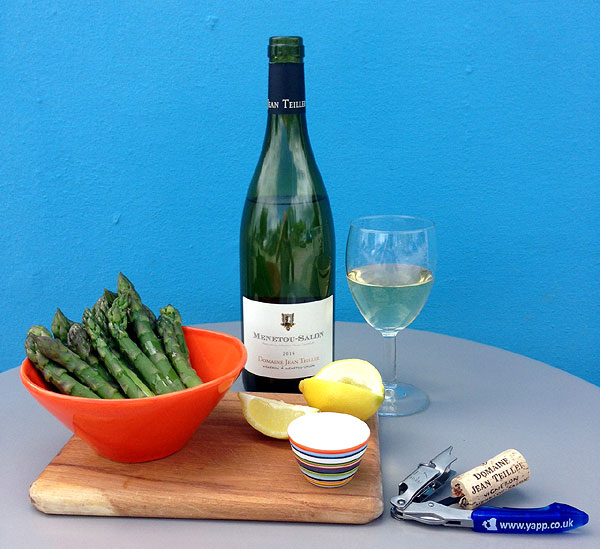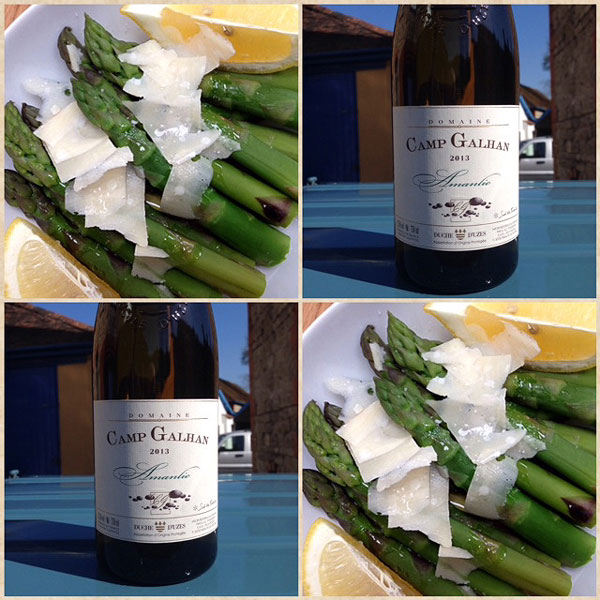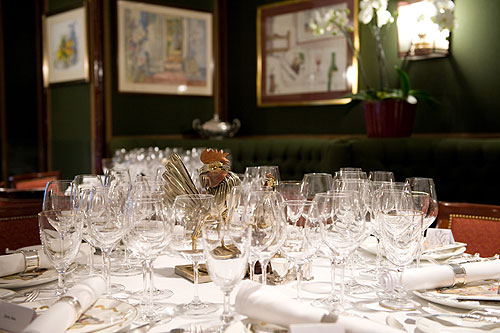Spears of Destiny
The U.K. asparagus season is necessarily short officially running from Saint George's day, which is also 'National Asparagus Day' on the 23rd April until 21st June. Most supermarkets stock imported asparagus, much of it from Peru, throughout the year but it has a lot of transportation miles and in my (heavily biased) opinion isn't nearly as good. I am a stickler for eating seasonal products where they are cultivated and in season so consume lots of British asparagus for the two months when it is available and don't when it isn't.
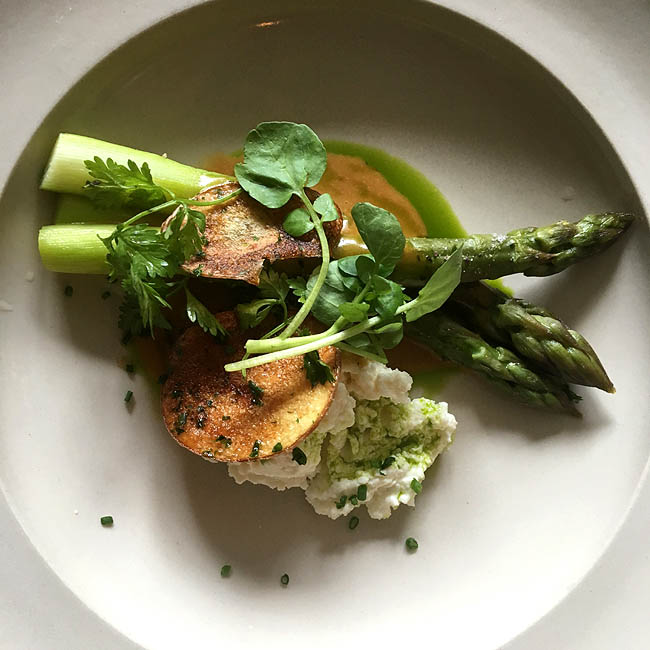
The Vale of Evesham in Worcestershire is the traditional heartland for cultivating British asparagus but Norfolk, Lincolnshire, Suffolk, Kent, Hertfordshire and other parts of central and southern England are also home to asparagus farms. Asparagus grows best in a mild climate and on sandy soils and, although it is a mild diuretic, it is rich in vitamin K and has long been perceived as being one of our healthier home grown vegetables.
The British Asparagus Growers Association, based in Louth in Licolnshire, cites five methods of cooking asparagus – boiling, steaming, grilling, roasting and barbecuing. I've tried my hand at all of those but, after years of experimentation, have settled on steaming as being the simplest and most effective method of cooking it. The main point to pay attention to is not to overcook it. Cooking times vary according to the thickness of the asparagus stems but I think about 5 minutes is optimum given that the asparagus will keep cooking after it is has been drained.
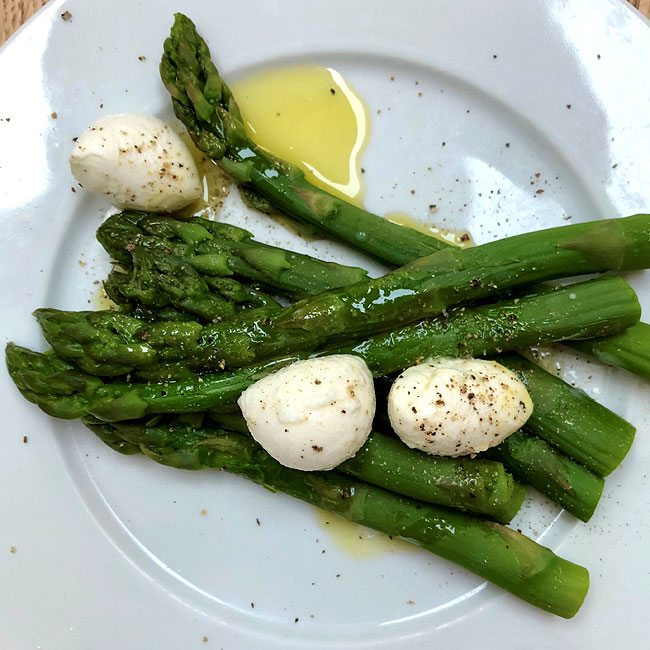
I usually rinse and trim the ends off the asparagus before steaming it in about 3 centimeters depth of (originally) cold water in a lidded pan placed on a hob on a medium heat. Once the water starts to boil I let it steam for about 3 minutes and then inspect the asparagus to monitor progress. A soon as the stems start to show some flexibility I remove the pan from the heat, drain it, then refresh the asparagus with cold water, to arrest the cooking progress, and immediately drain it again.
I like to serve asparagus when it is still warm, although I'm quite happy with it cold as a salad ingredient, and tend to just dress it with olive oil and a little sea salt. More often than I just enjoy it as a stand alone starter or side dish but parmesan, mozzarella, poached or boiled eggs and fresh bread are all eligible accompaniments.
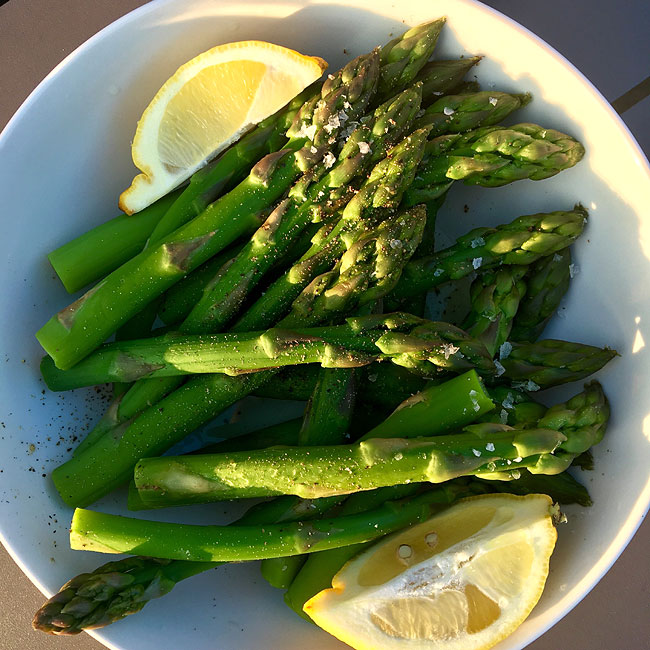
I think the limited availability of British asparagus perhaps adds to its appeal but one thing is certain I absolutely adore it and will never tire of it. In terms of wine pairing Sauvignon Blanc is arguably the 'classic' partner but there are other white grapes I prefer that I think work equally well – Chenin Blanc and Vermentino would be high on my short list but a good nervy Chardonnay in the form of an unoaked Chablis wouldn't go amiss either.
May Wines of the Month: £99.00 per case (of six bottles) delivered, saving £19.00 on list prices.
Aspire to Asparagus
The British asparagus season runs from the end of April until June and is a cause for celebration. Having eschewed inferior imports since the end of last season I intend to spend the month of May gorging on it, as it is by far my favourite vegetable. The British Asparagus Producers Association website (http://britishasparagus.com/) recommends five methods of cooking asparagus, which are: boil, steam, grill, roast and barbecue. While each practice has its merits, and I fully intend to deploy all five, I have, with age, come to the view that simple steaming is the best way of cooking the stuff; with the critical caveat that timing is everything. Crunchy, undercooked spears are always a disappointment, but soggy overcooked asparagus is a crime against humanity. My modus operandi with all but the stoutest stems is to rinse them under a tap and trim off the root ends and then place them in a heavy, cast-iron lidded pot with about a centimetre's depth of water in the bottom. I then bring the pan to the boil and as soon as it is steaming remove it from the heat and then check the asparagus every minute or so until it is nearly cooked, before 'refreshing' it momentarily it under cold water. It should finish cooking on latent heat – a fact which is often overlooked, which is why overcooking is a common problem.
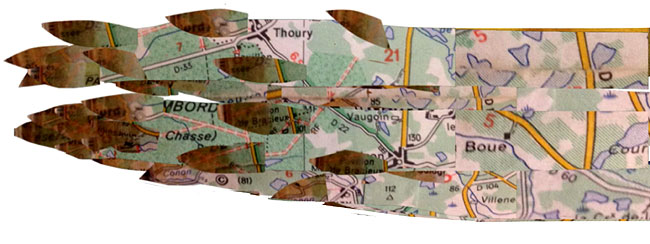
Asparagus by David Chandler
There is no doubting asparagus's versatility and I like it as much as an ingredient to soups, salads, quiches and frittatas as I do as a side dish, but I think its rightful place is really on its own – centre stage. Fellow enthusiasts enjoy it with poached eggs, pancetta, Iberico ham or hollandaise sauce, but it really needs nothing more than some good olive oil, salt and pepper and perhaps a delicate shaving of parmesan.
There are myriad options in terms of wine accompaniments. Although Vermentino or Chenin Blanc can both work well, I think cool climate Sauvignon is really the order of the day. With its aromas of nettles and elderflower that are so evocative of Spring, and its crisp, zesty finish it is a food and wine match made in heaven. A lightly-chilled bottle of this month's Menetou Salon would be perfect. I turn 50 in May and there are no prizes for guessing how I intend to celebrate.
May Wines of the Month: £80.00 per case (of six bottles) delivered, saving £17.90 on list prices.
The English asparagus season is upon us which is a cause of celebration in its own right. I boycott the inferior, factory farmed Peruvian stuff with its indefensible air miles, which is available all the year round in the supermarkets, so tend to go overboard when our peerless home grown spears become available. The big question, that I'm frequently asked, is: What wine to serve with this monarch of the vegetable world? For many years my default response was 'Sauvignon Blanc from the Loire Valley's Central Vineyards'. There is something about the racy minerality of a top notch Sancerre or Pouilly Fumé that has a magical affinity with the verdant, freshness of new season's asparagus.
As my culinary horizons extended I experimented with different cooking methods - having started out as a plain 'boiler' (oh the ignorance of youth) I became an ardent steamer (so sophisticated), then an oven roaster and finally an on-trend griddler and griller. How you cook asparagus and, moreover, what you choose to serve it with does have a bearing on what wines you can partner it with. At Le Gavroche, where they serve it with shavings of summer truffles, head sommelier David Galetti favours a Corsican Vermentino which is a bold and beautiful match as the sun-kissed, scrub scented wine marries perfectly with the tender stalks and earthy truffle flavours. If you adorn your asparagus with mozzarella, olive oil, Parma ham, Hollandaise sauce or shavings of Parmesan cheese it can stand up to Chenin Blancs, Pinot Grigio and lighter un-oaked Chardonnays.
A happy discovery last year was a white Appellation d'Origine Protégée 'Duché d'Uzès' from Domaine Camp Galhan called 'Cuvée Amanlie'. It is made by a chap called Lionel Pourquier from a blend of Viognier, Grenache Blanc and Roussanne and according to no lesser personage than Robert Parker it 'offers pungent cress, lemon zest, and white pepper along with ripe peach'. As well as being an accomplished wine-maker Lionel also cultivates asparagus so perhaps it is unsurprising that his Amanlie makes a magnificent accompaniment to it.
My rule of thumb is to avoid any wines that are too exotically scented, oaky or full-bodied and plump for nervy, youthful bottlings that capture the spirit of Spring. Today I've pretty much come full circle - if you lightly steam a generous quantity of spears (never too thick or fine), refresh them with cold water to arrest the cooking and dress them with good olive oil and lemon juice and a touch of salt and pepper and serve them with a chilled glass of Pouilly Fumé or such-like you can't really improve on that. I've just taken the photograph below, the sun is shining and you can guess what happened next!
It was a treat to be back at Le Gavroche for our annual Spring lunch yesterday playing to a full house of 100 diners keen to sample wines matched to a seasonal menu devised by Michel Roux Jr.
We kicked-off with a lively Vouvray Mousseux Brut from Domaine Aubert by way of aperitif, which guests could elect to taste with or without the addition of a dash of Gabriel Boudier’s peerless Crème de Cassis. The exercise of trying to serve canapés and drinks to 100 people in the bijou upstairs bar area at 43 Upper Brook Street always reminds me of seeing how many students can cram into a phone box. Fortunately, we have a loyal and resilient clientele and the intimacy of the surroundings definitely broke the ice.
Once seated in the comfort and splendour of the downstairs dining room the revels could commence with a fine pairing of a rare white Chinon from Château du Ligré and a weightier, oilier, organic Côtes du Luberon from Château la Canorgue – both in the newly released (and very promising) 2010 vintage. I then talked guests through the first 3 wines and Le Gavroche’s Executive Director, Silvano Giraldin, told us how the dishes we were about to sample had been selected and prepared. Kent asparagus with aged parmesan and truffle vinaigrette proved a popular pre-starter and had a terrific affinity for the white Chinon (see previous entry) but the ‘Oeuf Poche Victoria’ that followed was a veritable show-stopper. This dish is an old Roux family favourite – a poached egg served on a bed of lobster on top of an artichoke heart. There were lots of different flavours at work here and personally I thought this offering favoured the Château la Canorgue.
Our main course was a sublime collar of lamb confit served with white beans and wild garlic. We partnered this with a youthful red Vin de Corse Sartène 2009 from Domaine Saparale. The wild Maquis scents and tastes of this unusual Nielluccio-Sciacarello blend married perfectly with the tender, salty lamb so it was going to be a tough act to follow. Fortunately, Ron and Elva Laughton from Australia’s celebrated Jasper Hill estate in Heathcote were in town for the Natural Wine Fair and we indulged ourselves with their iconic Georgia’s Paddock Shiraz 2005. Ron told us about his non-interventionist wine growing philosophy and explained why he is an ardent champion of ‘dry-grown’ (un-irrigated) root-stock despite the pressures of draught and global warning.
A delicate dessert of vanilla panna cotta with Alphonso mango and ginger went down very well with Pascal Labasse’s Jurançon Mœlleux 2008. This unctuous sweet wine has a lovely palate-cleansing acidity to offset the tropical fruit flavours and I think it met with widespread approval.
We rounded off a very convivial event with coffee and Petits Fours and some stout-hearted folk even availed themselves of the digestif trolley before dispersing back into the daylight fully sated.
I am already keenly anticipating to our next visit in the Autumn because if you want to enjoy classic Gallic cuisine with superb service in elegant surroundings Le Gavroche sets the Gold Standard!
I was fortunate enough to spend last Thursday lunchtime at Le Gavroche selecting the wines for our forthcoming Spring lunch. I took the opportunity to buttonhole the head sommelier David Galetti, who presides over a list of biblical proportions, about his personal recommendations of wines to accompany asparagus.
When English asparagus is in season, as it is now, it can’t be beaten and my personal philosophy is to enjoy it as frequently as possible so I was keen to hear David’s recommendations. His first observation was that if asparagus is properly cooked it should still have a little bit of a ‘croquant’ bite and that you must therefore select a wine that is ‘fresh’ and isn’t heavily marked with oak. Although Sauvignon Blanc is widely acknowledged as being the classic accompaniment (and they list our Pouilly Fumé ‘Les Loges’ from Dominique Guyot in bottles and halves at Le Gavroche - which would be a good match) David said that it probably wouldn’t be his first choice. He looks for a wine with ‘a hint of citrus’ and averred that it is important to have some savoury herb notes too. Pinot Blanc and dry Chenin Blanc ‘can work very well’ apparently – so I look forward to experimenting with some of those forthwith. David dis-recommended Chardonnay as a general rule “you don’t want anything too heavy, oaky or buttery” and surprised me with the revelation that his personal preference is for a Corsican Vermentino!
So what are you waiting for? Get the green spears of goodness on the stove and start experimenting with some fresh, clean Spring whites in the newly shipped 2010 vintage.



